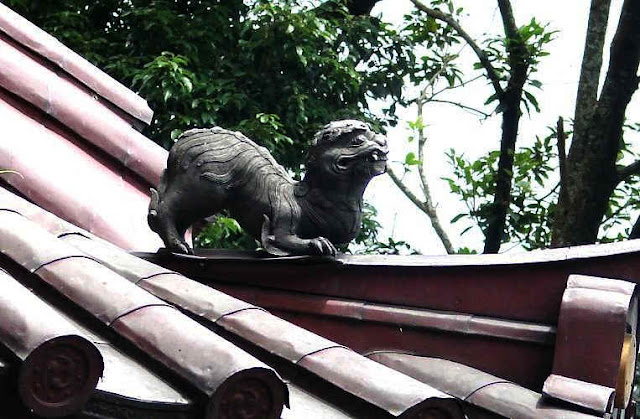Nishoyamada Shrine, located next to Kanyoji Temple, the next temple on the Chugoku Pilgrimage for me, has a delightful, long approach with plenty of Autumn colours....
The shrine was created in 1907 by the merging of two shrines, Nisho Daimyojin and Yamada Gonzensha
This was at the peak of the governments program to drastically reduce the number of shrines in the country.
Other shrines in the grounds that were moved here around the same time is a large shrine to Sugawara Michizane, commonly referred to as Tenjin. There is aaslo a small Kibune Shrine and a Gokoku Shrine, the local version of Yasukuni, the modern shrine enshrining war dead.
The Nisho Shrine was established in 899. moved in 1262, and then moved to its current location in 1674.
The primary kami are Omononushi and Yachihoko, which is curious as they are both aliases of Okuninushi.
Secondary kami associated with the former Nisho Shrine are Sukunahikona, Susano, Kagutsuchi, Kotoshironushi, Ichikishimahime, and Kakinomoto Hitomaro. Most are considered the Izumo pantheon, though Kakinomoto is a curiosity.
Yamada Shrine was established in 1292, but a theory is that it existed much earlier as a clan shrine and in the 13th century was made a branch of Ise Shrines.
The primary kami are Amaterasu and Toyoke.
The secondary kami are Amenokoyane, Ukemochi, and Sarutahiko. Okuninushi and Susano are also listed as secondary kami of the former Yamada Shrine.
In 1906 the head priest started manufacturing omikuji as a source of income and now the company produces 70% of all omikuji in Japan. They also invented the machines for dispensing omikuji at unmanned shrines. Omikuji were originally something developed in Tendai temples connected with Kannon, and during the Edo Period spread by Yin Yang diviners. Shrines started to promote them around the early 20th century
The shrine is located in Shunan City, Yamaguchi, though actually it is quite a remote area in the mountains about 25k north of Tokuyama.
It is close to the expressway, and there is an infrequent bus from Tokuyama that comes to the temple next door.
if you would like to subscribe by email, just leave your email address in the comments below. It will not be published or made public. I post new content almost every day, and send out an email about twice a month with short descriptions and links to the most recent posts.































































